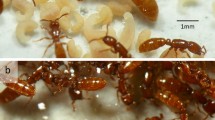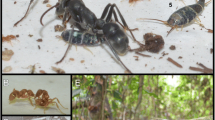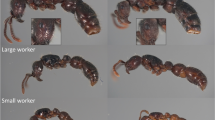Summary
-
1.
Morphological evidence indicates the Southeast Asian genusProatta is phylogenetically close to the Attini. The gyne ofProatta is described for the first time.
-
2.
Colonies ofProtta butteli are polygynous, with numerous queens present. There is no evidence for aggression between queens or differential treatment of queens by workers. Also, there is no sign of intraspecific aggression: the ants readily accepted workers transplanted from distant sites.
-
3.
Workers search for food solitarity, foraging only a short distance (invariably less than a meter) from each nest entrance. Within the limited foraging area worker density tends to be high, and clumps of as many as 50 foragers are sometimes present. This foraging pattern allows for rapid exploitation of discovered food. Recruitment occurs along odor trails formed from a pheromone originating in the poison gland.
-
4.
In addition to small prey and scavenged arthropod corpses, the ants capture prey larger than themselves. Such prey are taken by an inchoate form of group predation. The first worker to encounter the prey attempts to restrain it. Because of the high forager density, additional workers soon arrive seemingly by chance and aid in pinning the prey in place. Unlike attine ants,Proatta butteli does not feed on fungi.
-
5.
The worker repertoire, temporal division of labor, and emigration behavior are discussed. Although workers vary little in head width (0.51 to 0.70 mm) they show a modest division of labor by size, with smaller individuals being relatively numerous in the brood area.
Zusammenfassung
-
1.
Morphologische Belege legen den Schluss nahe, dass die südostasiatische Ameisengattungproatta phylogenetisch der Tribus Attini nahe steht. Die Königin vonProatta wird erstmals beschrieben.
-
2.
Kolonien vonProatta butteli sind polygn. Aggression zwischen den Königinnen oder unterschiedliches Verhalten der Arbeiterinnen zu bestimmten Königinnen konnte nicht beobachtet werden. Intraspezifische Aggression scheint nicht zu existieren: die Ameisen können leicht zwischen entfernten Nestern ausgetauscht werden.
-
3.
Arbeiter gehen einzeln auf Futtersuche; sie entfernen sich dabei kaum weiter als 1 Meter vom Nesteingang. Innerhalb des begrenzten Fouragierbereiches ist die Arbeiterdichte oft beträchtlich; bisweilen findet man bis zu 50 Futtersucher an einem Fleck. Dieses Fouragierverhalten ermöglicht eine schnelle Ausbeutung von Futterquellen. Mit Hilfe von Spurpheromonen, die aus der Giftdrüse stammen, werden Nestgenossen rekrutiert.
-
4.
Meist erbeuten die Ameisen kleine Beuteobjekte, doch manchmal werden auch Beutetiere, die grösser als die Ameisen sind, gefangen. Dies geschieht durch ein einfaches, kooperatives Beuteverhalten. Anders als Arten der Tribus Attini ernährt sichProatta butteli nicht von Pilzen.
-
5.
Das Verhaltensrepertoire, Arbeitsteilung und Emigrationsverhalten werden diskutiert. Obgleich die Arbeiterinnen nur wenig in der Kopfkapselbreite variieren (0.51 bis 0.70 mm), zeigen sie doch eine gewisse grössenabhängige Arbeitsteilung, wobei die kleineren Individuen häufiger im Brutnest vorkommen.
Similar content being viewed by others
References
Emery C., 1922. — Hymenoptera. Family Formicidae, subfamily Myrmicinae.In, P. Wytsman (ed.)General Insectorum, Fasc. 174, V. Verteneuil and L. Desmet, Brussels, 397 pp. 7 pl.
Fagen R.M., Goldman R.N., 1977. — Behavioral catalogue analysis methods.Anim. Behav., 25, 261–274.
Forel A., 1912. — Descriptions provisoires de genres, sous-genres et espèces de Formicides des Indes orientales.Rev. Suisse Zool., 20, 761–774.
Garling L., 1979. — Origin of ant-fungus mutualism: a new hypothesis.Biotropica, 11, 284–291.
Gotwald W.H., 1982. — Army ants, pp. 157–254. In Hermann H.R. (Ed.),Social Insects, Vol. IV. Academic Press, New York.
Hölldobler B., 1983. — Territorial behavior in the green tree ant (Oecophylla smaragdina).Biotropica, 15, 241–250.
Hölldobler B., Stanton R.C., Mark H., 1978. — Recruitment and food-retrieving behavior inNovomessor (Formicidae, Hymenoptera).Behav. Ecol. Sociobiol., 4, 163–181.
Hölldobler B., Wilson E.O., 1978. — The multiple recruitment systems of the African weaver antOecophylla longinoda (Latreille) (Hymenoptera: Formicidae).Behav. Ecol. Sociobiol., 3, 19–60.
Hölldobler B., Wilson E.O., 1986. — Soil-binding pilosity and camouflage in ants of the tribes Basicerotini and Stegomyrmecini (Hymenoptera: Formicidae).Zoomorphol., 106, 12–20.
Ihering H. Von, 1894. — Die Ameisen von Rio Grande do Sul.Berlin Entomol. Ztschrft, 39, 321–446.
Moffett M.W., 1984. — Swarm raiding in a myrmicine antNaturwissenschaften, 71, 588–590.
Weber N.A., 1958. — Nomenclatural notesProatta andAtta (Hym.: Formicidae).Entomol. News, 69, 7–13.
Weber N.A., 1972. —Gardening ants, the Attines. Memoir no. 92, American Philosophical Society, Philadelphia, 146 pp.
Wheeler G.C., Wheeler J., 1985. — The larva ofProatta (Hymenoptera: Formicidae).Psyche, 92, 447–450.
Wilson E.O., 1971. —The Insect Societies. Belknap Press of Harvard University Press, Cambridge, 548 pp.
Wilson E.O., Brown W.L., 1984. — Behavior of the cryptobiotic predaceous antEurhopalothrix heliscata, n.sp. (Hymenoptera: Formicidae: Basicerotini).Insect. Soc., 31, 408–428.
Zar J.H., 1984. —Biostatistical Analysis. Prentice-Hall, New Jersey, 718 pp.
Author information
Authors and Affiliations
Rights and permissions
About this article
Cite this article
Moffett, M.W. Behavior of the group-predatory antProatta butteli (Hymenoptera: Formicidae): An old world relative of the attine ants. Ins. Soc 33, 444–457 (1986). https://doi.org/10.1007/BF02223950
Received:
Accepted:
Issue Date:
DOI: https://doi.org/10.1007/BF02223950




